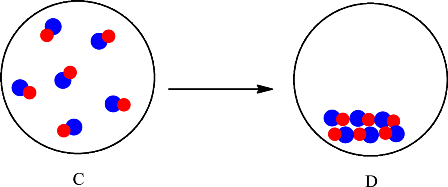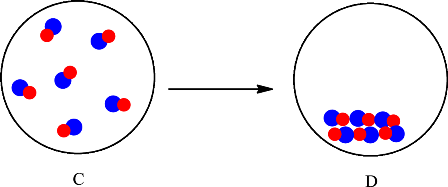
Concept explainers
(a)
Interpretation:
Whether the following change is physical or chemical is to be determined.
Concept introduction:
The change that takes place only in state or appearance and not in the composition is known as physical change. The atoms or the molecules of a substance do not change their identity when a substance undergoes a physical change. The change accompanied by the change in the physical properties only is classified as physical change. The substance remains the same before and after the change. For example, the melting of ice is a physical change.
The change that takes place in the composition is known as chemical change. The atoms or the molecules of the substance rearrange and transformed into a new substance. For example, the burning of paper is a chemical change.
(a)
Answer to Problem 1.1P
The mixing of substances in A and B to give substance in C is a chemical change.
Explanation of Solution
The change is depicted as follows:

Each sphere represents one particle or atom. Atoms from A react with the atoms in B to form a new substance with one red and one blue atom depicted in the C. Formation of a new substance in a change is classified as a chemical change. Thus, the mixing of substances in A and B to give substance in C is a chemical change.
The particles in the A interact with the particles in B and result in the formation of new substance (change in composition). Therefore, it can be classified as a chemical change.
(b)
Interpretation:
Whether the following change is physical or chemical is to be determined.
Concept introduction:
The change that takes place only in state or appearance and not in the composition is known as physical change. The atoms or the molecules of a substance do not change their identity when a substance undergoes a physical change. The change accompanied by the change in the physical properties only is classified as physical change. The substance remains the same before and after the change. For example, the melting of ice is a physical change.
The change that takes place in the composition is known as chemical change. The atoms or the molecules of the substance rearrange and transformed into a new substance. For example, the burning of paper is a chemical change.
(b)
Answer to Problem 1.1P
The mixing of substances in A and B to give substance in D is a chemical change.
Explanation of Solution
The change is depicted as follows:

Each sphere represents one particle or atom. Atoms from A react with the atoms in B to form a new substance with one red and one blue atom depicted in the D. Formation of a new substance in a change is classified as a chemical change. Thus, the change is classified as a physical change. Therefore, the mixing of substances in A and B to give substance in D is a chemical change.
The particles in A interact with the particles in B and result in the formation of new substance (change in composition). Therefore, it can be classified as a chemical change.
(c)
Interpretation:
Whether the following change is physical or chemical is to be determined.
Concept introduction:
The change that takes place only in state or appearance and not in the composition is known as physical change. The atoms or the molecules of a substance do not change their identity when a substance undergoes a physical change. The change accompanied by the change in the physical properties only is classified as physical change. The substance remains the same before and after the change. For example, the melting of ice is a physical change.
The change that takes place in the composition is known as chemical change. The atoms or the molecules of the substance rearrange and transformed into a new substance. For example, the burning of paper is a chemical change.
(c)
Answer to Problem 1.1P
The conversion of substance C into D is a physical change.
Explanation of Solution
The change is depicted as follows:

Each sphere represents one particle or atom. C consists of molecules made up of one red sphere and one blue sphere. D also consists of molecules made up of one red sphere and one blue sphere. The only difference is in the arrangement of the particles in C and D. In C the particles are far apart from each other and are in the gaseous state whereas in D the particles are arranged in a regular pattern and in the solid state. Since no new substance is formed, therefore conversion of substance C into D is considered as a physical change.
The particles in C rearranged to give substance D. Since no new substance is formed the change is classified as a physical change.
(d)
Interpretation:
Whether the following change is accompanied by the change in physical properties or chemical properties is to be determined.
Concept introduction:
The change that takes place only in state or appearance and not in the composition is known as physical change. The atoms or the molecules of a substance do not change their identity when a substance undergoes a physical change. The change accompanied by the change in the physical properties only is classified as physical change. The substance remains the same before and after the change. For example, the melting of ice is a physical change.
The change that takes place in the composition is known as chemical change. The atoms or the molecules of the substance rearrange and transformed into a new substance. For example, the burning of paper is a chemical change.
(d)
Answer to Problem 1.1P
After the change in part (c) has occurred the sample have different physical properties.
Explanation of Solution
The change is depicted as follows:

Each sphere represents one particle or atom. C consists of molecules made up of one red sphere and one blue sphere. D also consists of molecules made up of one red sphere and one blue sphere. The only difference is in the arrangement of the particles in C and D. In C the particles are far apart from each other and are in the gaseous state whereas in D the particles are arranged in a regular pattern and in the solid state. Since no new substance is formed, therefore conversion of substance C into D is considered as a physical change.
The change is physical change, therefore, substance C and D will have the same chemical properties but different physical properties.
The particles in C rearranged to give substance D. Since no new substance is formed the substance C and D are the same therefore they will have the same chemical properties but different physical properties.
Want to see more full solutions like this?
Chapter 1 Solutions
CHEMISTRY:MOLEC NAT PRINT COMPANION
- Briefly state the electrocapillary equation for ideally polarized electrodes.arrow_forwardWhat is surface excess according to the Gibbs model?arrow_forwardUsing Benzene as starting materid show how each of the Following molecules Contel Ve syntheswed CHI 9. b -50311 с CHY 503H Ночто d. อ •NOV e 11-0-650 NO2arrow_forward
- The molecule PYRIDINE, 6th electrons and is therefore aromatre and is Assigned the Following structure contering Since aromatk moleculoy undergo electrophilic anomatic substitution, Pyridine shodd undergo The Following reaction + HNO3 12504 a. write all of the possible Mononitration Products that could Result From this reaction 18. Bared upon the reaction mechanison determime which of these producty would be the major Product of the hegetionarrow_forwarda. Explain Why electron withdrawing groups tend to be meta-Directors. Your answer Should lyclude all apropriate. Resonance contributing Structures fo. Explain why -ll is an outho -tura drccton even though chlorine has a very High Electronegativityarrow_forward9. Write Me product as well as the reaction Mechanism For each of the Following Vanctions +H₂504 4.50+ T C. +212 Fellz 237 b. Praw the potential energy Diagrams For each OF Mese Rauctions and account For any differences that appear in the two potential Puergy Diagrams which of here two reactions 19 Found to be Reversable, Rationalice your answer based upon the venation mechanisms and the potential energy diagrams.arrow_forward
- 9. Write Me product as well as the reaction Mechanism For each of the Following Veritious +H2504 4.50+ + 1/₂ Felly ◎+ 7 b. Praw he potential energy Diagrams For each OF Mese Ronctions and account for any differences that appeak in the two potential Puergy Diagramsarrow_forwardDraw the major product of this reaction. Ignore inorganic byproducts. Incorrect, 3 attempts remaining 1. excess Br2, NaOH 2. neutralizing workup Qarrow_forwardGiven the electrode Pt | Ag | Ag+ (aq), describe it.arrow_forward
 ChemistryChemistryISBN:9781305957404Author:Steven S. Zumdahl, Susan A. Zumdahl, Donald J. DeCostePublisher:Cengage Learning
ChemistryChemistryISBN:9781305957404Author:Steven S. Zumdahl, Susan A. Zumdahl, Donald J. DeCostePublisher:Cengage Learning ChemistryChemistryISBN:9781259911156Author:Raymond Chang Dr., Jason Overby ProfessorPublisher:McGraw-Hill Education
ChemistryChemistryISBN:9781259911156Author:Raymond Chang Dr., Jason Overby ProfessorPublisher:McGraw-Hill Education Principles of Instrumental AnalysisChemistryISBN:9781305577213Author:Douglas A. Skoog, F. James Holler, Stanley R. CrouchPublisher:Cengage Learning
Principles of Instrumental AnalysisChemistryISBN:9781305577213Author:Douglas A. Skoog, F. James Holler, Stanley R. CrouchPublisher:Cengage Learning Organic ChemistryChemistryISBN:9780078021558Author:Janice Gorzynski Smith Dr.Publisher:McGraw-Hill Education
Organic ChemistryChemistryISBN:9780078021558Author:Janice Gorzynski Smith Dr.Publisher:McGraw-Hill Education Chemistry: Principles and ReactionsChemistryISBN:9781305079373Author:William L. Masterton, Cecile N. HurleyPublisher:Cengage Learning
Chemistry: Principles and ReactionsChemistryISBN:9781305079373Author:William L. Masterton, Cecile N. HurleyPublisher:Cengage Learning Elementary Principles of Chemical Processes, Bind...ChemistryISBN:9781118431221Author:Richard M. Felder, Ronald W. Rousseau, Lisa G. BullardPublisher:WILEY
Elementary Principles of Chemical Processes, Bind...ChemistryISBN:9781118431221Author:Richard M. Felder, Ronald W. Rousseau, Lisa G. BullardPublisher:WILEY





